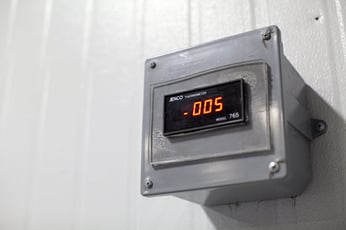Storing different temperature-sensitive products together is a little like running a pet store. While they may have very different care requirements, a lizard, a puppy, and a goldfish can all co-exist safely under the same pet shop roof provided their individual needs are met.
The same holds true in the warehouse, as products with totally different – and often opposite – requirements can be stored together safely as long as appropriate measures are taken.
Can One Warehouse Store Different Temperature-Sensitive Products Together?
 At Weber, this is one of the most common logistics questions we receive from companies who have multiple products with different requirements.
At Weber, this is one of the most common logistics questions we receive from companies who have multiple products with different requirements.
The answer is “yes” – it is not only possible to do this, it’s often the optimal way to store your products.
For example, one of Weber’s customers is a major food and beverage supplier to the airline industry, providing the food and beverage items served on the flights of its airline partners. When you consider the variety of foods and beverages served on the average flight, you can quickly understand that their warehousing requirements are all over the map.
The meat products and bread must be stored frozen; the dairy products must be refrigerated; confectionery products must be kept at 65 degrees; while other products like pretzels and popcorn have much less stringent requirements.
If you’re responsible for the care of these products within the supply chain, you really have two options:
- You can store each group of products at separate warehouses according to their temperature requirements (i.e., frozen goods at one warehouse, chocolate at another, etc.), while managing inventory and coordinating transportation across multiple locations.
- Or, you can entrust your products to one third-party logistics provider (3PL) who can handle multi-temp warehousing under one roof while also performing inventory and temperature-controlled transport.
Put that way, the choice is simple. But…
How simple is this one-source solution to implement?
It’s simpler than you may think. Warehousing of different types of temperature-sensitive products boils down to three things: specs, systems, and space.
Specs – Your products each have temperature-related requirements that they must adhere to. These are not only based on FDA regulations, but also on your own specific requirements to ensure the freshness, potency, longevity, and shelf-life of each product. Once these specifications are fully understood by both you and a prospective 3PL provider, the next issue is…
Systems – Knowing the specific temperature requirements of your products, your warehousing provider must be able to ensure that these requirements can be met 100% of the time using temperature- and humidity-regulation systems. Products with similar temperature requirements will typically be stored in the same “temperature zone” within the warehouse. From there, an array of additional systems is needed. These include:
- Monitoring systems to ensure appropriate conditions
- Inventory and warehouse management (WMS) systems to keep track of products, orders, and approaching expiration dates
- Practices and procedures related to equipment, maintenance, temperature logs, repair, training, and certifications, such as AIB
Space – With the specs and systems in place, it then becomes a matter of what a given facility’s size and space (and permits) can handle. Some facilities have the space and systems to securely house multiple temperature zones, while other facilities can only safely house a few zones or may specialize in just one.
Importantly, the space between the zones matters just as much as the storage capacity within. Each zone must comply with strict regulations to prevent cross-contact. For example, a few open doors at the wrong place at the wrong time can alter the temperature of a given zone and put the integrity of products at risk.
Weber Solutions for Temperature-Sensitive Products
At Weber’s facilities, we have isolated temperature zones for a wide variety of products, from ice-cold frozen goods to chemicals that need to be stored at 80 degrees – with many additional zones for every temperature range in-between. Even our docks are temperature controlled.
And, much like the pet store’s lizard, puppy, and goldfish, Weber has the specs, the systems, and the space to keep products with varying temperature needs secure and safe from cross-contamination.
Product safety and integrity is always job #1 at Weber. So, in addition to the robust systems we have in place, Weber has an onsite maintenance team that is at the ready in the extremely rare event that any issue occurs with those systems.
Weber’s temperature-related services also extend beyond the warehouse. Our temperature-controlled transportation fleet ensures that your products remain at their required temperature on each leg of the supply chain journey.
To learn more about Weber’s solutions for temperature-sensitive products, contact us today.






 Capital Management
Capital Management